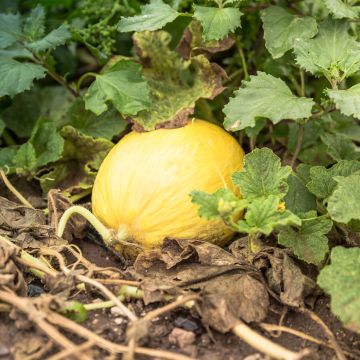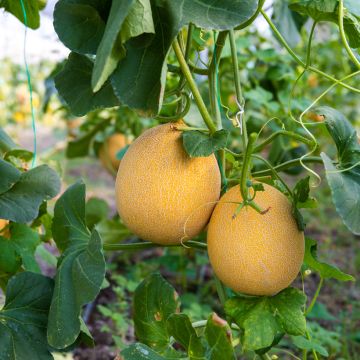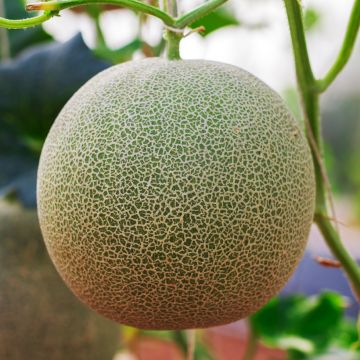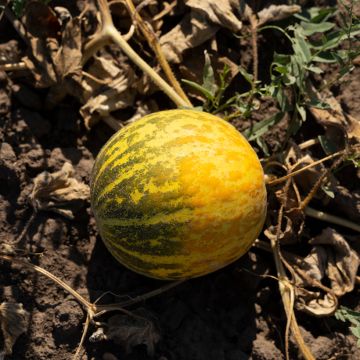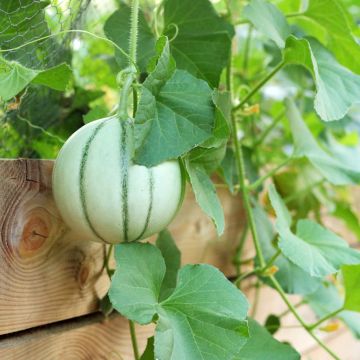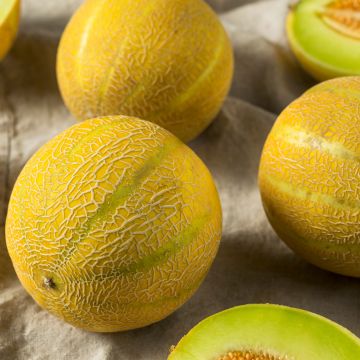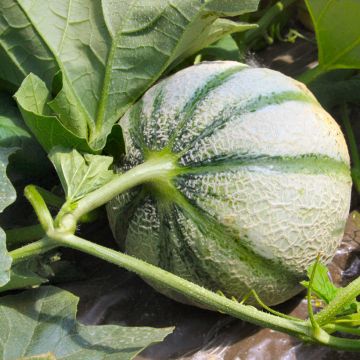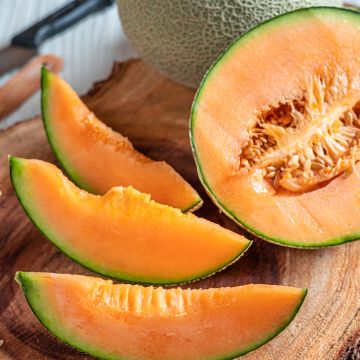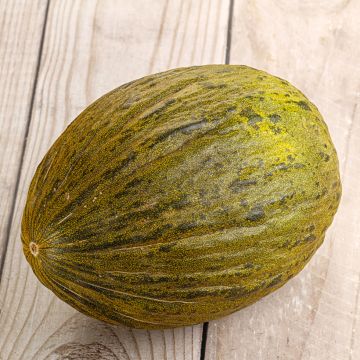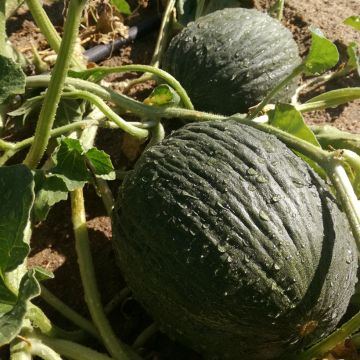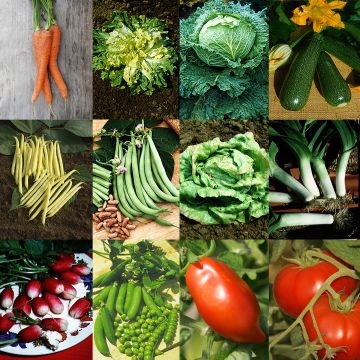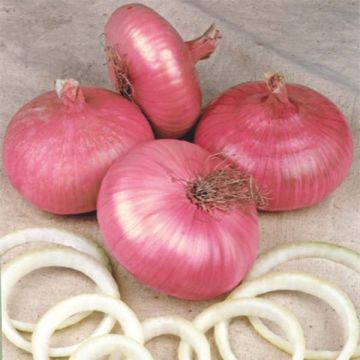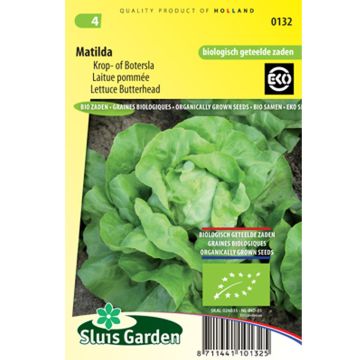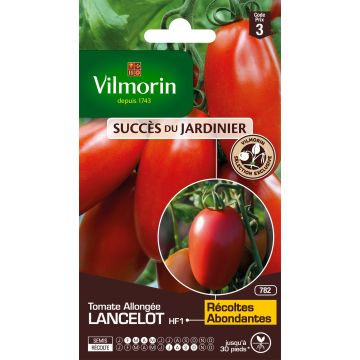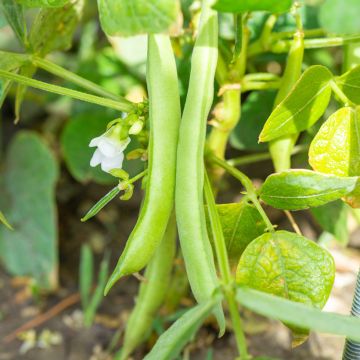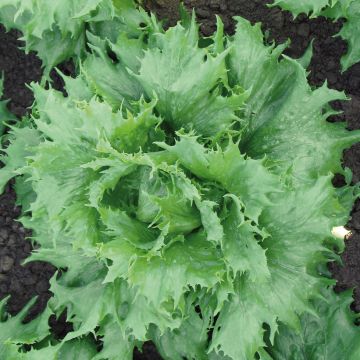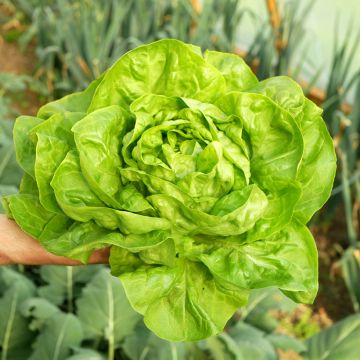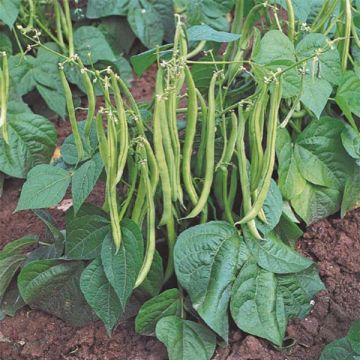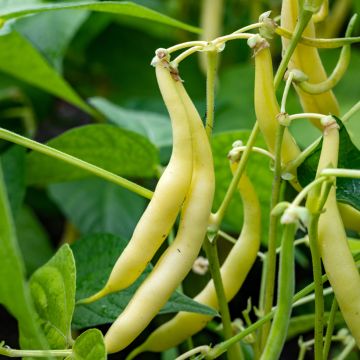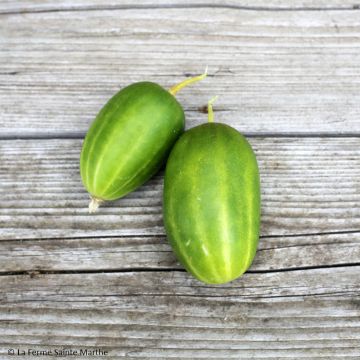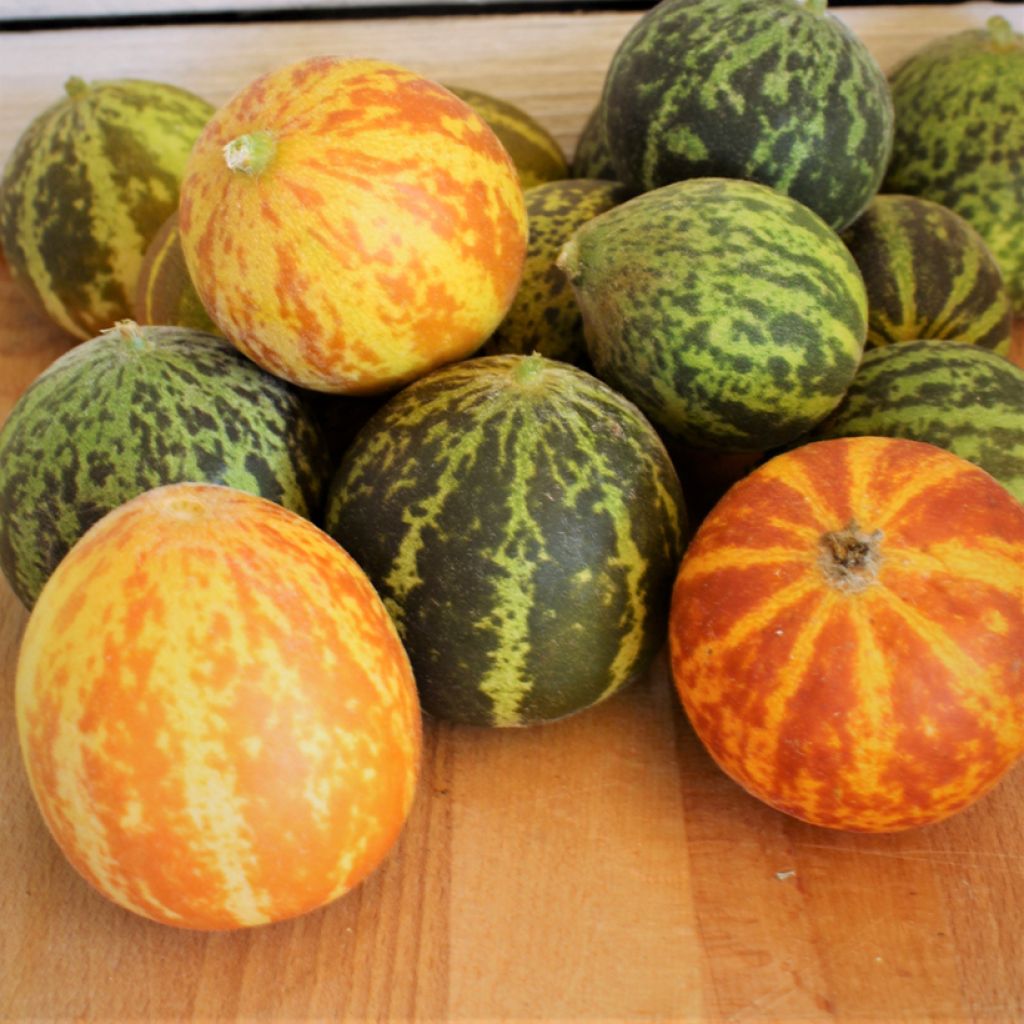

Cucumis melo Dudaim
Cucumis melo Dudaim
Cucumis melo var. dudaim Queen Anne's Pocket
Melon
This item cannot be shipped to the selected country
Dispatch by letter from €3.90
More information
Schedule delivery date,
and select date in basket
This plant carries a 6 months recovery warranty
More information
We guarantee the quality of our plants for a full growing cycle, and will replace at our expense any plant that fails to recover under normal climatic and planting conditions.
Seed-only orders are dispatched by sealed envelope. The delivery charge for seed-only orders is €3.90.
Description
The Queen Anne's Pocket Melon (Cucumis melo dudaim), also known as the Queen Anne's Melon or Dudaïm Cucumber, is an annual climbing plant distinguished by its remarkably aromatic small yellow-orange fruits. Appreciated for its ornamental qualities, this melon brings a unique touch to the garden, whether planted directly in the ground or in a pot on the terrace.
The Queen Anne's Pocket Melon, belonging to the Cucurbitaceae family, originates from Central Asia, a region known for its rich diversity of flora. This plant with long climbing stems, equipped with tendrils, can reach up to 2 m in height. This variety has been particularly popular since the 19th century, as evidenced by its mention in the reference work Les plantes potagères by Vilmorin-Andrieu in 1883, where it is described as a horticultural curiosity.
Queen Anne's Pocket Melon produces small fruits, comparable to tennis balls, about 6 to 8 cm in diameter. Their yellow-orange skin is marked with fine stripes, giving the fruits a decorative appearance. The flesh is white and without notable taste, surrounded by a velvety skin. What truly sets this melon apart is its strong aroma, a fragrance that evokes summer and lingers long after harvest.
The discreet flowering consists of small yellow flowers typical of the Cucurbitaceae, which appear a few weeks after sowing. The plant is annual and requires approximately 80 to 90 days after sowing to produce its first fruits. Sow this melon under cover from April, or directly in place in May, after the last frosts. Harvest from July to September.
Harvesting: about four weeks are needed between fruit formation and the picking time. The sweet scent emitted by the fruit and the stalk about to detach indicate that they are ready. These small melons are mainly used for decoration. They release a strong and pleasant fragrance, which can be used to scent the house. They can be placed in baskets or bowls as table ornaments, or even hung in clusters.
Storage: Small pocket melons generally keep for 1 to 3 months after harvesting. Their thick skin and small size contribute to their good conservation, but the exact duration may vary depending on storage conditions. To prolong their pleasant fragrance, it is advisable to keep them in a dry and well-ventilated place, at room temperature or cooler.
Gardener's Tip:
Melons are very prone to powdery mildew (a fungal disease leaving a white fuzz on the leaves). Carefully avoid watering the leaves or flowers. Melons are very nutrient-demanding fruits. Like cucumbers, watermelons, squash, etc., they deplete the soil's nutrients. Therefore, it is advisable not to grow this type of fruit-vegetable always in the same place or in succession, to avoid excessively impoverishing the soil.
In the garden, pair the pocket melon with morning glories, these plants will climb on trellises. Nasturtiums will complement the pocket melon well with their brightly coloured flowers and similar growth. You can also plant it alongside passion flowers, their exotic flowers will perfectly accompany the sweet fragrance of the melon.
Report an error about the product description
Harvest
Plant habit
Foliage
Botanical data
Cucumis
melo var. dudaim
Queen Anne's Pocket
Cucurbitaceae
Melon
Cucumis dudaim
Cultivar or hybrid
Annual
Other Melon seeds
Planting and care
Soil preparation: Melon plants appreciate moist, well-drained soils. Prepare the soil by aerating it to a depth of about ten cm without turning it over. Melons need a soil rich in nutrients and plenty of warmth for successful fruiting. To help them, dig a hole to accommodate the young plant, fill it with well-decomposed manure or compost, and mix it with the soil to avoid root burn. The location should be very sunny, with ideally sandy, well-drained soil slightly acidic in pH. If the soil is not well-drained, create a small mound for each plant.
Sowing under glass: Melons can be grown in vegetable gardens. However, it is often better to sow them on a warm bed under a greenhouse, before transplanting them into the ground. Starting from the end of March, fill your pots or trays with seed compost and plant the melon seeds, tip down, to facilitate root development. Keep the soil moderately moist. The seeds usually germinate within 14 days. Once the plants have three true leaves, you can transplant them into the ground. Make sure beforehand that the soil is warm enough, with a temperature between 18 and 26°C for optimal growth. Space each plant 80 cm apart in all directions.
Sowing in open ground: In southern regions, melon seeds can be sown directly in open ground. Ensure that the soil is adequately warmed beforehand. Sow two to three seeds in small holes, tips pointing downwards. Repeat the process, spacing them at least 90 cm apart in all directions. Keep the soil moderately moist. When the plants have three true leaves, keep the most vigorous one.
Seedlings
Care
Intended location
This item has not been reviewed yet - be the first to leave a review about it.
Vegetable seeds
Haven't found what you were looking for?
Hardiness is the lowest winter temperature a plant can endure without suffering serious damage or even dying. However, hardiness is affected by location (a sheltered area, such as a patio), protection (winter cover) and soil type (hardiness is improved by well-drained soil).

Photo Sharing Terms & Conditions
In order to encourage gardeners to interact and share their experiences, Promesse de fleurs offers various media enabling content to be uploaded onto its Site - in particular via the ‘Photo sharing’ module.
The User agrees to refrain from:
- Posting any content that is illegal, prejudicial, insulting, racist, inciteful to hatred, revisionist, contrary to public decency, that infringes on privacy or on the privacy rights of third parties, in particular the publicity rights of persons and goods, intellectual property rights, or the right to privacy.
- Submitting content on behalf of a third party;
- Impersonate the identity of a third party and/or publish any personal information about a third party;
In general, the User undertakes to refrain from any unethical behaviour.
All Content (in particular text, comments, files, images, photos, videos, creative works, etc.), which may be subject to property or intellectual property rights, image or other private rights, shall remain the property of the User, subject to the limited rights granted by the terms of the licence granted by Promesse de fleurs as stated below. Users are at liberty to publish or not to publish such Content on the Site, notably via the ‘Photo Sharing’ facility, and accept that this Content shall be made public and freely accessible, notably on the Internet.
Users further acknowledge, undertake to have ,and guarantee that they hold all necessary rights and permissions to publish such material on the Site, in particular with regard to the legislation in force pertaining to any privacy, property, intellectual property, image, or contractual rights, or rights of any other nature. By publishing such Content on the Site, Users acknowledge accepting full liability as publishers of the Content within the meaning of the law, and grant Promesse de fleurs, free of charge, an inclusive, worldwide licence for the said Content for the entire duration of its publication, including all reproduction, representation, up/downloading, displaying, performing, transmission, and storage rights.
Users also grant permission for their name to be linked to the Content and accept that this link may not always be made available.
By engaging in posting material, Users consent to their Content becoming automatically accessible on the Internet, in particular on other sites and/or blogs and/or web pages of the Promesse de fleurs site, including in particular social pages and the Promesse de fleurs catalogue.
Users may secure the removal of entrusted content free of charge by issuing a simple request via our contact form.
The flowering period indicated on our website applies to countries and regions located in USDA zone 8 (France, the United Kingdom, Ireland, the Netherlands, etc.)
It will vary according to where you live:
- In zones 9 to 10 (Italy, Spain, Greece, etc.), flowering will occur about 2 to 4 weeks earlier.
- In zones 6 to 7 (Germany, Poland, Slovenia, and lower mountainous regions), flowering will be delayed by 2 to 3 weeks.
- In zone 5 (Central Europe, Scandinavia), blooming will be delayed by 3 to 5 weeks.
In temperate climates, pruning of spring-flowering shrubs (forsythia, spireas, etc.) should be done just after flowering.
Pruning of summer-flowering shrubs (Indian Lilac, Perovskia, etc.) can be done in winter or spring.
In cold regions as well as with frost-sensitive plants, avoid pruning too early when severe frosts may still occur.
The planting period indicated on our website applies to countries and regions located in USDA zone 8 (France, United Kingdom, Ireland, Netherlands).
It will vary according to where you live:
- In Mediterranean zones (Marseille, Madrid, Milan, etc.), autumn and winter are the best planting periods.
- In continental zones (Strasbourg, Munich, Vienna, etc.), delay planting by 2 to 3 weeks in spring and bring it forward by 2 to 4 weeks in autumn.
- In mountainous regions (the Alps, Pyrenees, Carpathians, etc.), it is best to plant in late spring (May-June) or late summer (August-September).
The harvesting period indicated on our website applies to countries and regions in USDA zone 8 (France, England, Ireland, the Netherlands).
In colder areas (Scandinavia, Poland, Austria...) fruit and vegetable harvests are likely to be delayed by 3-4 weeks.
In warmer areas (Italy, Spain, Greece, etc.), harvesting will probably take place earlier, depending on weather conditions.
The sowing periods indicated on our website apply to countries and regions within USDA Zone 8 (France, UK, Ireland, Netherlands).
In colder areas (Scandinavia, Poland, Austria...), delay any outdoor sowing by 3-4 weeks, or sow under glass.
In warmer climes (Italy, Spain, Greece, etc.), bring outdoor sowing forward by a few weeks.

































